How to remove apps designed to promote saytoyoup.fun?
Notification SpamAlso Known As: Ads by saytoyoup.fun
Get free scan and check if your device is infected.
Remove it nowTo use full-featured product, you have to purchase a license for Combo Cleaner. Seven days free trial available. Combo Cleaner is owned and operated by RCS LT, the parent company of PCRisk.com.
What is saytoyoup[.]fun?
Depending on visitor's geolocation, the saytoyoup[.]fun page can open other untrustworthy websites or load its content. Either way, saytoyoup[.]fun is not a trustworthy website.
There are many examples of pages similar to saytoyoup[.]fun, some of them are ctivetothe[.]online, christianivory[.]pro, and android-system[.]live. It is important to mention that users do not intentionally open such pages - browsers automatically open them when they have some potentially unwanted application (PUA) installed on them.
It is also common that that sites like saytoyoup[.]fun get opened through deceptive ads and other untrustworthy pages.
![saytoyoup[.]fun pop-up redirects](/images/stories/screenshots202105/saytoyoup-fun-ads-main.jpg)
Usually, websites like saytoyoup[.]fun open about two or three other dubious pages or load their deceptive content. Most of them are designed to promote download websites for adware, browser hijackers, and other PUAs, deceptive pages used to trick visitors into providing personal information, transferring money, paying for unnecessary or even fake software, and so on.
Some examples of pages that sites like saytoyoup[.]fun can be used to promote are "Chrome Search Contest 2021", "Error Code: #0x564897", "Home Improvement Reward". Furthermore, it is common that pages like saytoyoup[.]fun use one or another clickbait technique to trick their visitors into clicking the "Allow" button.
For example, they show a fake CAPTCHA test asking visitors to click the "Allow" button to prove that they are not robots. Saytoyoup[.]fun displays a message saying to tap the "Allow" button to continue loading the website.
That button allows websites to show their notifications. It is strongly advisable not to agree to receive any notifications from pages like saytoyoup[.]fun. Most of the notifications that come from such pages are designed to advertise untrustworthy web pages, potentially malicious apps, various scams, etc.
It is important to mention that PUAs (apps that often are responsible for the promotion of pages like saytoyoup[.]fun) can be designed to collect browsing-related details and generate advertisements. Most of them are likely to be designed to target geolocations, entered search queries, URLs of visited (opened) websites, Internet Protocol addresses.
However, some of them can be designed to collect sensitive information, such as credit card details and passwords. Examples of ads that PUAs can generate are banners, coupons, surveys, various pop-up ads.
It is common that those ads are used to advertise shady pages. Although, they can be used to distribute unwanted apps by designing them to run certain scripts as well. Therefore, users should never have any PUAs installed on browsers or computers.
| Name | Ads by saytoyoup.fun |
| Threat Type | Push notifications ads, Unwanted ads, Pop-up ads |
| Detection Names | ESET (Malware), Full List Of Detections (VirusTotal) |
| Serving IP Address | 54.237.125.12 |
| Symptoms | Seeing advertisements not originating from the sites you are browsing. Intrusive pop-up ads. Decreased Internet browsing speed. |
| Distribution Methods | Deceptive pop-up ads, potentially unwanted applications (adware) |
| Damage | Decreased computer performance, browser tracking - privacy issues, possible additional malware infections. |
| Malware Removal (Windows) |
To eliminate possible malware infections, scan your computer with legitimate antivirus software. Our security researchers recommend using Combo Cleaner. Download Combo CleanerTo use full-featured product, you have to purchase a license for Combo Cleaner. 7 days free trial available. Combo Cleaner is owned and operated by RCS LT, the parent company of PCRisk.com. |
In conclusion, saytoyoup[.]fun and various other shady pages are often promoted through PUAs. As mentioned in the previous paragraphs, apps of this kind can be used to promote websites and collect various data and feed users with advertisements.
As a rule, PUAs are completely useless to their users, even if they are advertised as legitimate applications that have some features, and so on.
Typically, they are designed only to generate revenue for their developers. Either way, any installed PUA should be uninstalled as soon as possible and never installed again.
How did adware install on my computer?
It is quite popular for potentially unwanted applications to be distributed by integrating them into downloaders or installers for other programs as extra offers. This distribution method is called "bundling".
As a rule, users can find integrated PUAs in "Advanced", "Custom", "Manual" or other settings, or near ticked checkboxes that those downloaders or installers have.
Users agree to download or install included applications when they do not check the aforementioned settings and use them to decline unwanted offers. Sometimes, users cause undesired downloads or installations through deceptive advertisements - by clicking ads designed to execute certain scripts.
How to avoid installation of potentially unwanted applications?
It is strongly recommended not to use third-party downloaders, installers, Peer-to-Peer networks (e.g., torrent clients, eMule), shady pages, etc., as sources for downloading or installing programs, files. The main reason why they cannot be trusted is that they can be used to distribute both PUAs and malicious applications.
Files and programs should come from official websites and through direct links. Downloaders and installers that have ticked checkboxes or "Custom", "Advanced" (or some other) settings are likely to be bundled with PUAs.
Therefore, they should be checked for undesired offers. Advertisements on questionable websites (for example, sites related to pornography, gambling, adult dating) should not be trusted.
It is likely that those would be designed to advertise untrustworthy pages or cause unwanted downloads, installations. Unwanted applications (extensions, plug-ins, or add-ons) installed on a web browser should be removed.
Software of this kind installed on a computer should be uninstalled too. If your computer is already infected with rogue applications, we recommend running a scan with Combo Cleaner Antivirus for Windows to automatically eliminate them.
Appearance of saytoyoup[.]fun website (GIF):
![saytoyoup[.]fun website appearance (GIF)](/images/stories/screenshots202105/saytoyoup-fun-ads-appearance.gif)
Notifications from saytoyoup[.]fun:
Instant automatic malware removal:
Manual threat removal might be a lengthy and complicated process that requires advanced IT skills. Combo Cleaner is a professional automatic malware removal tool that is recommended to get rid of malware. Download it by clicking the button below:
DOWNLOAD Combo CleanerBy downloading any software listed on this website you agree to our Privacy Policy and Terms of Use. To use full-featured product, you have to purchase a license for Combo Cleaner. 7 days free trial available. Combo Cleaner is owned and operated by RCS LT, the parent company of PCRisk.com.
Quick menu:
- What is Ads by saytoyoup.fun?
- STEP 1. Remove spam notifications from Google Chrome
- STEP 2. Remove spam notifications from Google Chrome (Android)
- STEP 3. Remove spam notifications from Mozilla Firefox
- STEP 4. Remove spam notifications from Microsoft Edge
- STEP 5. Remove spam notifications from Safari (macOS)
Disable unwanted browser notifications:
Video showing how to disable web browser notifications:
 Remove spam notifications from Google Chrome:
Remove spam notifications from Google Chrome:
Click the Menu button (three dots) on the right upper corner of the screen and select "Settings". In the opened window select "Privacy and security", then click on "Site Settings" and choose "Notifications".
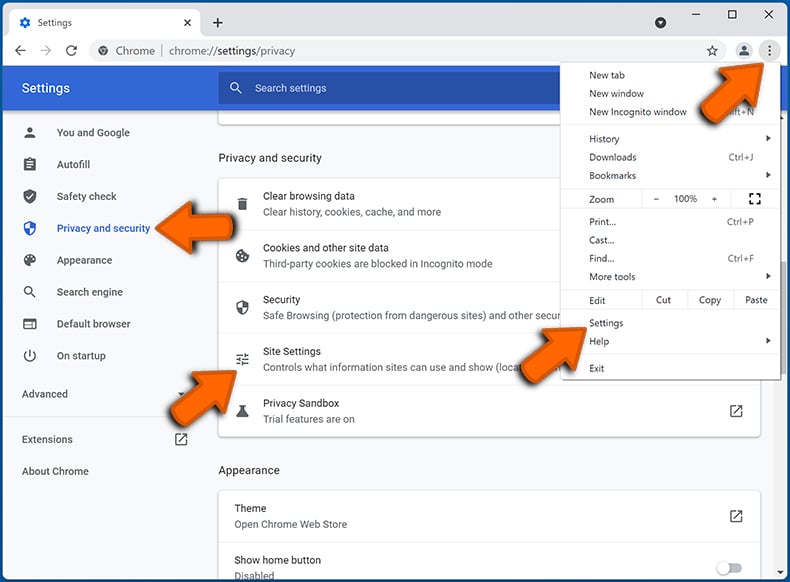
In the "Allowed to send notifications" list search for websites that you want to stop receiving notifications from. Click on the three dots icon near the website URL and click "Block" or "Remove" (if you click "Remove" and visit the malicious site once more, it will ask to enable notifications again).
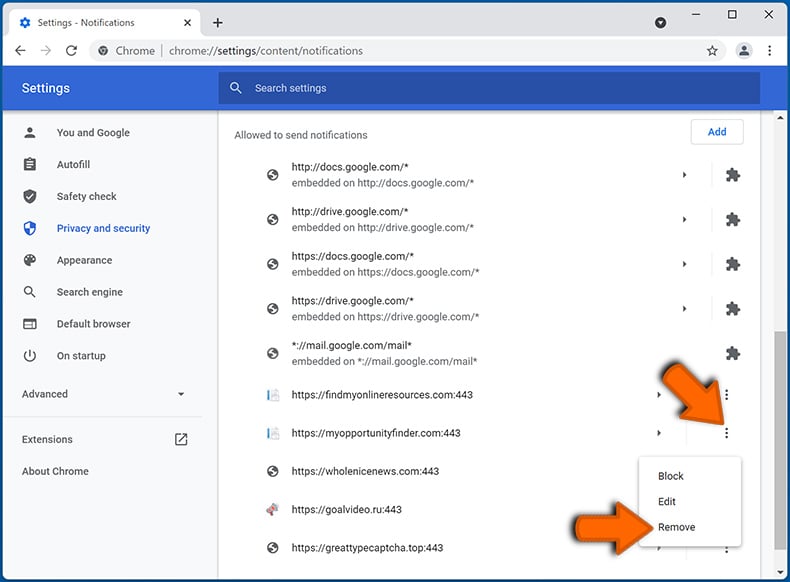
 Remove spam notifications from Google Chrome (Android):
Remove spam notifications from Google Chrome (Android):
Tap the Menu button (three dots) on the right upper corner of the screen and select "Settings". Scroll down, tap on "Site settings" and then "Notifications".
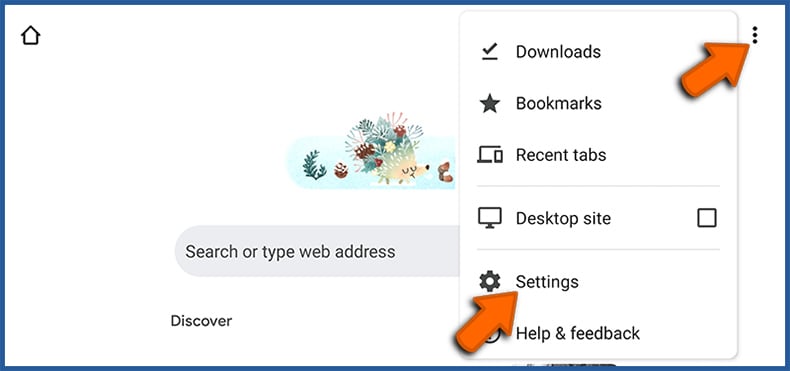
In the opened window, locate all suspicious URLs and tap on them one-by-one. Once the pop-up shows up, select either "Block" or "Remove" (if you tap "Remove" and visit the malicious site once more, it will ask to enable notifications again).
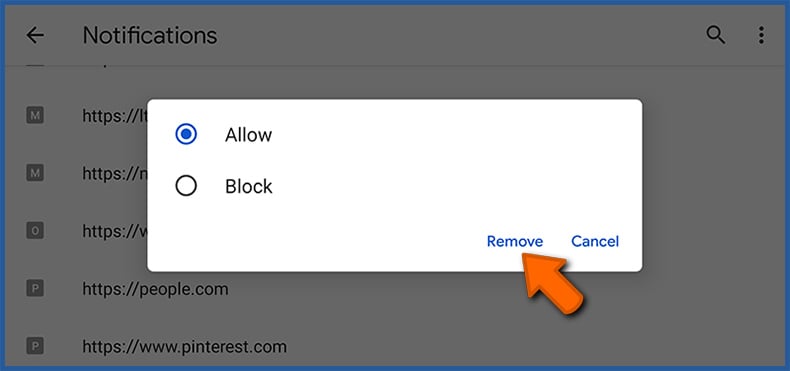
 Remove spam notifications from Mozilla Firefox:
Remove spam notifications from Mozilla Firefox:
Click the Menu button (three bars) on the right upper corner of the screen. Select "Settings" and click on "Privacy & Security" in the toolbar on the left hand side of the screen. Scroll down to the "Permissions" section and click the "Settings" button next to "Notifications".
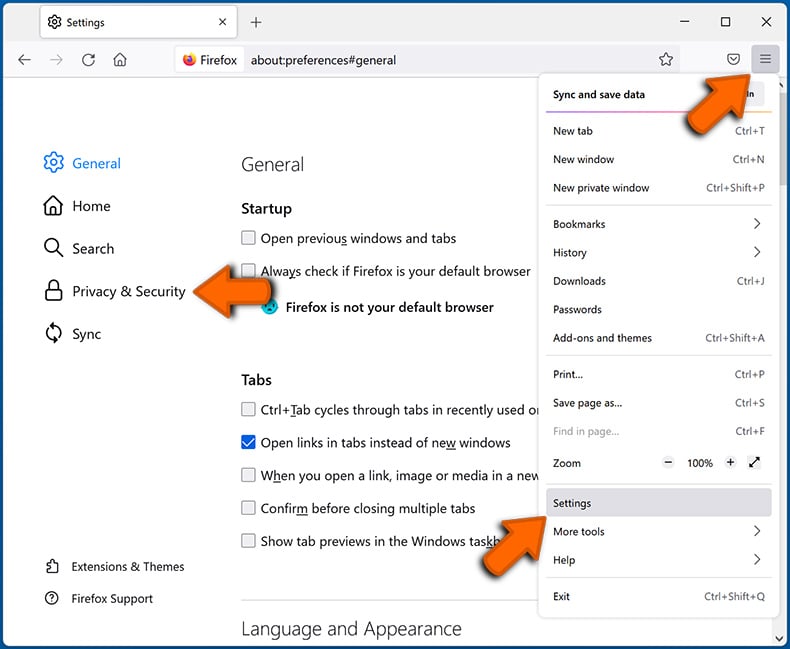
In the opened window, locate all suspicious URLs and block them using the drop-down menu or either remove them by clicking "Remove Website" at the bottom of the window (if you click "Remove Website" and visit the malicious site once more, it will ask to enable notifications again).
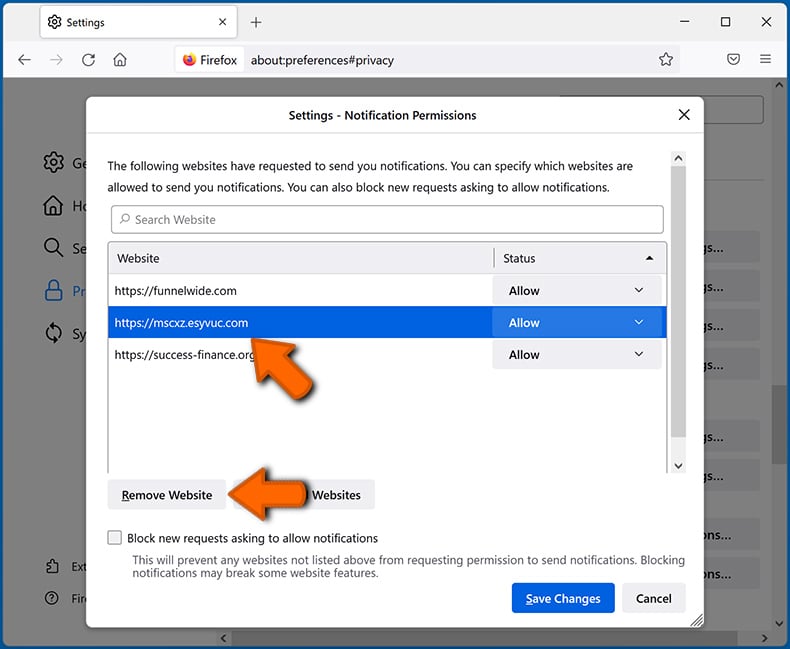
 Remove spam notifications from Microsoft Edge:
Remove spam notifications from Microsoft Edge:
Click the menu button (three dots) on the right upper corner of the Edge window and select "Settings". Click on "Cookies and site permissions" in the toolbar on the left hand side of the screen and select "Notifications".
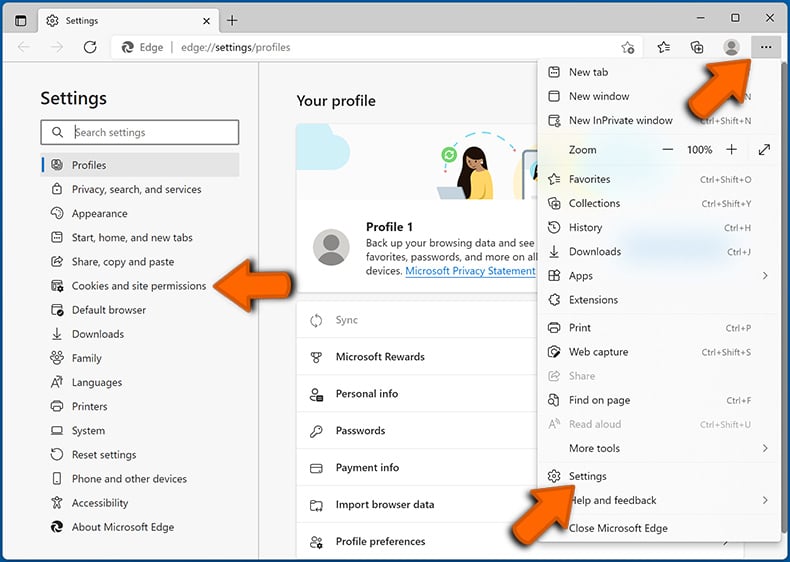
Click three dots on the right hand side of each suspicious URL under "Allow" section and click "Block" or "Remove" (if you click "Remove" and visit the malicious site once more, it will ask to enable notifications again).
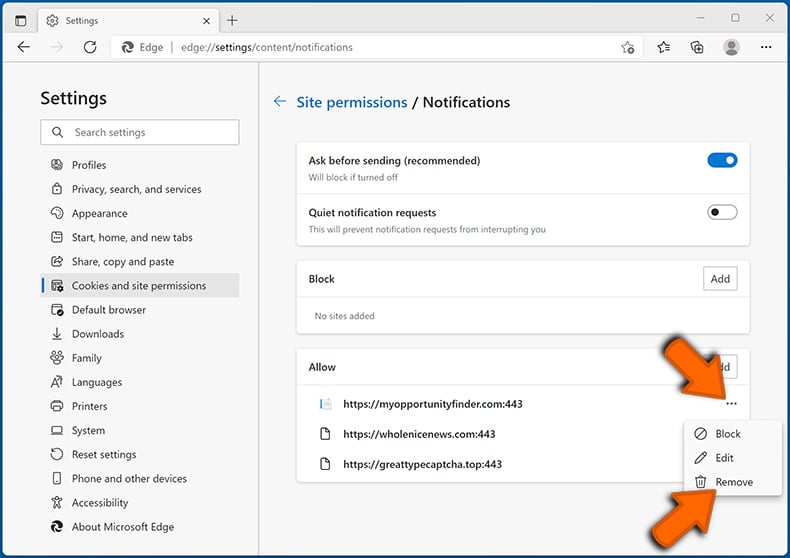
 Remove spam notifications from Safari (macOS):
Remove spam notifications from Safari (macOS):
Click "Safari" button on the left upper corner of the screen and select "Preferences...". Select the "Websites" tab and then select "Notifications" section on the left pane.
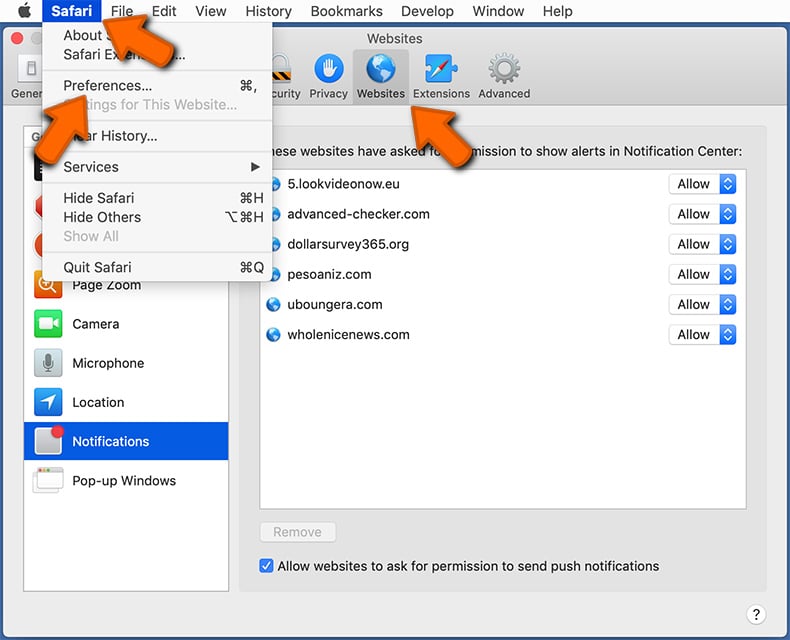
Check for suspicious URLs and apply the "Deny" option using the drop-down menu or either remove them by clicking "Remove" at the bottom of the window (if you click "Remove" and visit the malicious site once more, it will ask to enable notifications again)
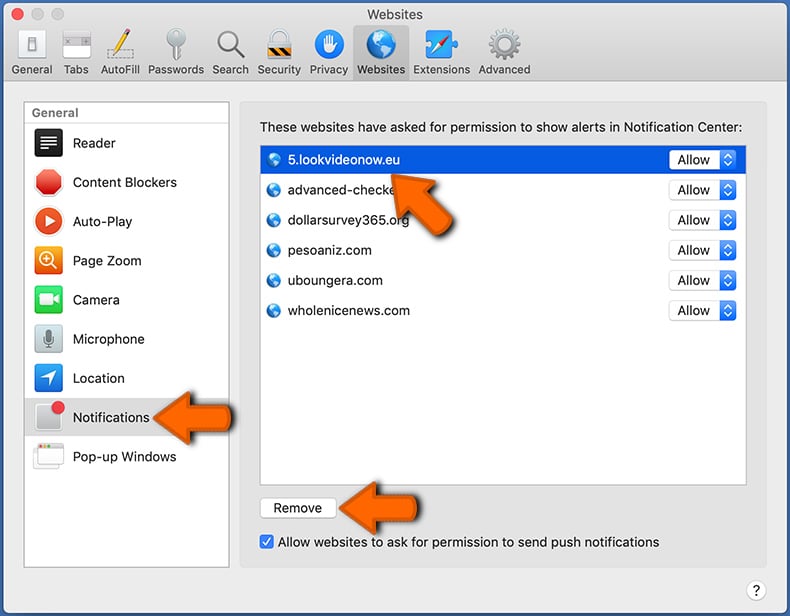
How to avoid browser notification spam?
Internet users should be very skeptical when being asked to allow notifications. While this is a useful feature that allows you to receive timely news from websites you like, deceptive marketers frequently abuse it.
Only allow notifications from websites that you fully trust. For added security - use an anti-malware application with a real-time web browsing monitor to block shady websites that tries to trick you into allowing spam notifications. We recommend using Combo Cleaner Antivirus for Windows.
Share:

Tomas Meskauskas
Expert security researcher, professional malware analyst
I am passionate about computer security and technology. I have an experience of over 10 years working in various companies related to computer technical issue solving and Internet security. I have been working as an author and editor for pcrisk.com since 2010. Follow me on Twitter and LinkedIn to stay informed about the latest online security threats.
PCrisk security portal is brought by a company RCS LT.
Joined forces of security researchers help educate computer users about the latest online security threats. More information about the company RCS LT.
Our malware removal guides are free. However, if you want to support us you can send us a donation.
DonatePCrisk security portal is brought by a company RCS LT.
Joined forces of security researchers help educate computer users about the latest online security threats. More information about the company RCS LT.
Our malware removal guides are free. However, if you want to support us you can send us a donation.
Donate



▼ Show Discussion